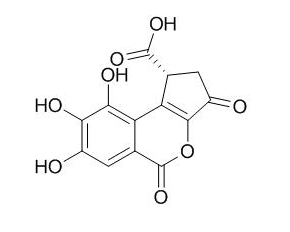Brevifolincarboxylic acid
Brevifolincarboxylic acid shows moderate antibacterial activity against Salmonella enteritidis , Salmonella typhimurium , and Salmonella abony, it (IC50 = 18.0 uM) also shows good antioxidant activity. Brevifolincarboxylic acid shows marked inhibitory effects on aryl hydrocarbon receptor -based bioassay activation by TCDD, and its effect is dose dependent.
Inquire / Order:
manager@chemfaces.com
Technical Inquiries:
service@chemfaces.com
Tel:
+86-27-84237783
Fax:
+86-27-84254680
Address:
1 Building, No. 83, CheCheng Rd., Wuhan Economic and Technological Development Zone, Wuhan, Hubei 430056, PRC
Providing storage is as stated on the product vial and the vial is kept tightly sealed, the product can be stored for up to
24 months(2-8C).
Wherever possible, you should prepare and use solutions on the same day. However, if you need to make up stock solutions in advance, we recommend that you store the solution as aliquots in tightly sealed vials at -20C. Generally, these will be useable for up to two weeks. Before use, and prior to opening the vial we recommend that you allow your product to equilibrate to room temperature for at least 1 hour.
Need more advice on solubility, usage and handling? Please email to: service@chemfaces.com
The packaging of the product may have turned upside down during transportation, resulting in the natural compounds adhering to the neck or cap of the vial. take the vial out of its packaging and gently shake to let the compounds fall to the bottom of the vial. for liquid products, centrifuge at 200-500 RPM to gather the liquid at the bottom of the vial. try to avoid loss or contamination during handling.
Spectrochim Acta A2019, 210:372-380
Acta Biochim Pol.2015, 62(2):253-8
Molecules.2021, 26(3):695.
Molecules.2016, 21(10)
United States Patent Application2020, 20200038363
Oxid Med Cell Longev.2021, 2021:6647107.
International. J. of Food Properties 2017, 20:S131-S140
Microchemical Journal2023. 191:108938
JMSACL2023, 09.002
Int J Mol Sci.2022, 23(5):2796.
Related and Featured Products
African Journal of Biotechnology, 2007 , 6 (14) :1685-1689.
In vitro assays for bioactivity-guided isolation of antisalmonella and antioxidant compounds in Thonningia sanginea flowers[Reference:
WebLink]
Bioguided fractionation of the aqueous extract of Thonningia sanguinea flowers, used traditionally in the treatment of microbial diseases, led to the isolation of two phenolic compounds.
METHODS AND RESULTS:
The structure of these compounds was elucidated by 1H, 13C 1D NMR and mass spectrometry experiments. The antibacterial activity against Salmonella strains and antioxidant activity of the crude extract, fractions and isolated compounds was evaluated using the DPPH method. The isolated compounds identified as Brevifolincarboxylic acid and gallic acid demonstrates moderate antibacterial activity against Salmonella enteritidis , Salmonella typhimurium , and Salmonella abony .
CONCLUSIONS:
The results indicated that the two isolated compounds, gallic acid (IC50 = 13.5 μM) and Brevifolincarboxylic acid (IC50 = 18.0 μM) were mainly responsible for the good scavenging activity of the aqueous extract.
Biol Pharm Bull. 2003 Dec;26(12):1754-60.
Screening of the inhibitory effect of vegetable constituents on the aryl hydrocarbon receptor-mediated activity induced by 2,3,7,8-tetrachlorodibenzo-p-dioxin.[Pubmed:
14646185]
The aryl hydrocarbon receptor (AhR) is a ligand-activated nuclear transcription factor that mediates responses to environmental contaminants such as dioxins, which have many adverse health effects.
METHODS AND RESULTS:
We performed a preliminary screening of the inhibitory effects of vegetable constituents on 2,3,7,8-tetrachlorodibenzo-p-dioxin (TCDD)-induced activation of AhR using the AhR-based bioassay for dioxins, the Ah-Immunoassay. Ninety vegetable constituents including flavonoids, tannins, saponins, terpenes, etc., were assayed in vitro. Among them, flavones, flavonols, anthraquinones, piperine, coumestrol, Brevifolincarboxylic acid, and resveratrol showed marked inhibitory effects on AhR-based bioassay activation by TCDD, and their effects were dose dependent. Curcumin, carnosol, and capsaicin also inhibited the activation of AhR in this assay, although to a lesser degree.
CONCLUSIONS:
These results suggest that several vegetable constituents might play a role in protection against dioxin toxicity.



